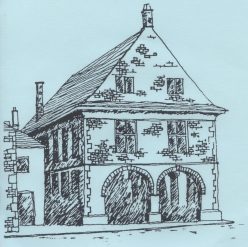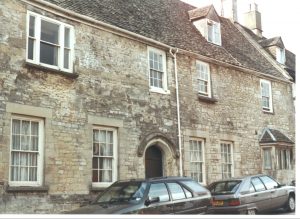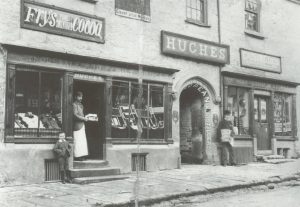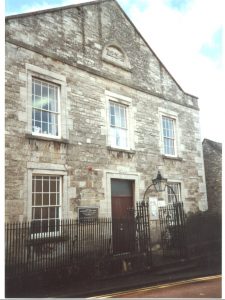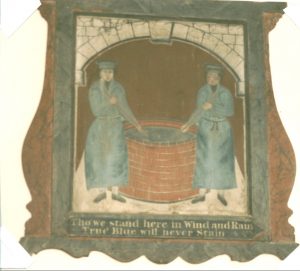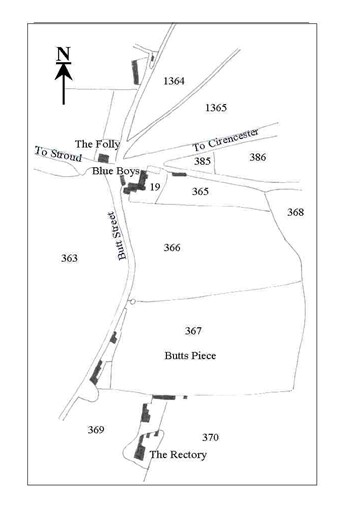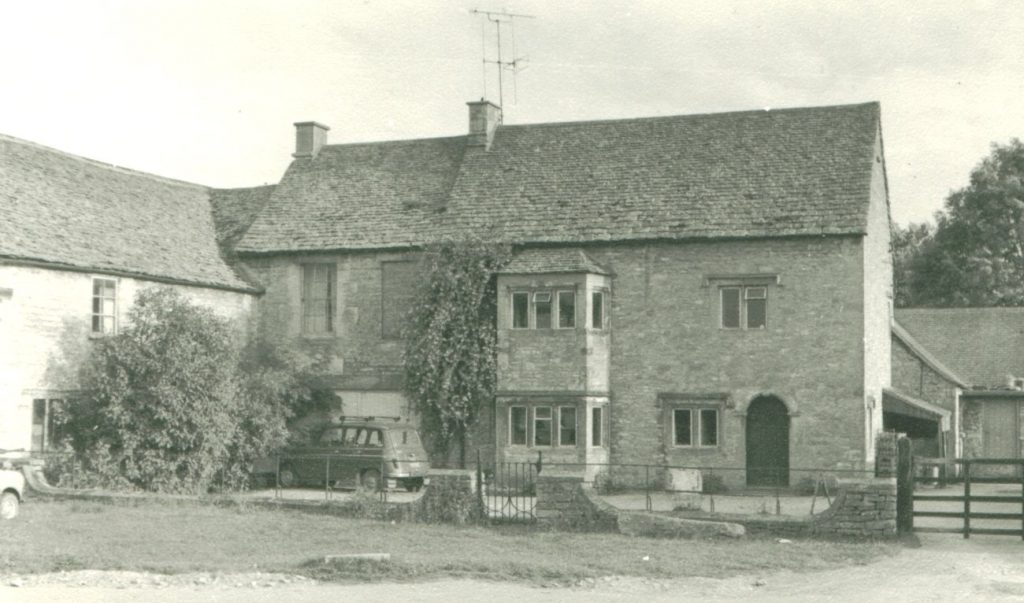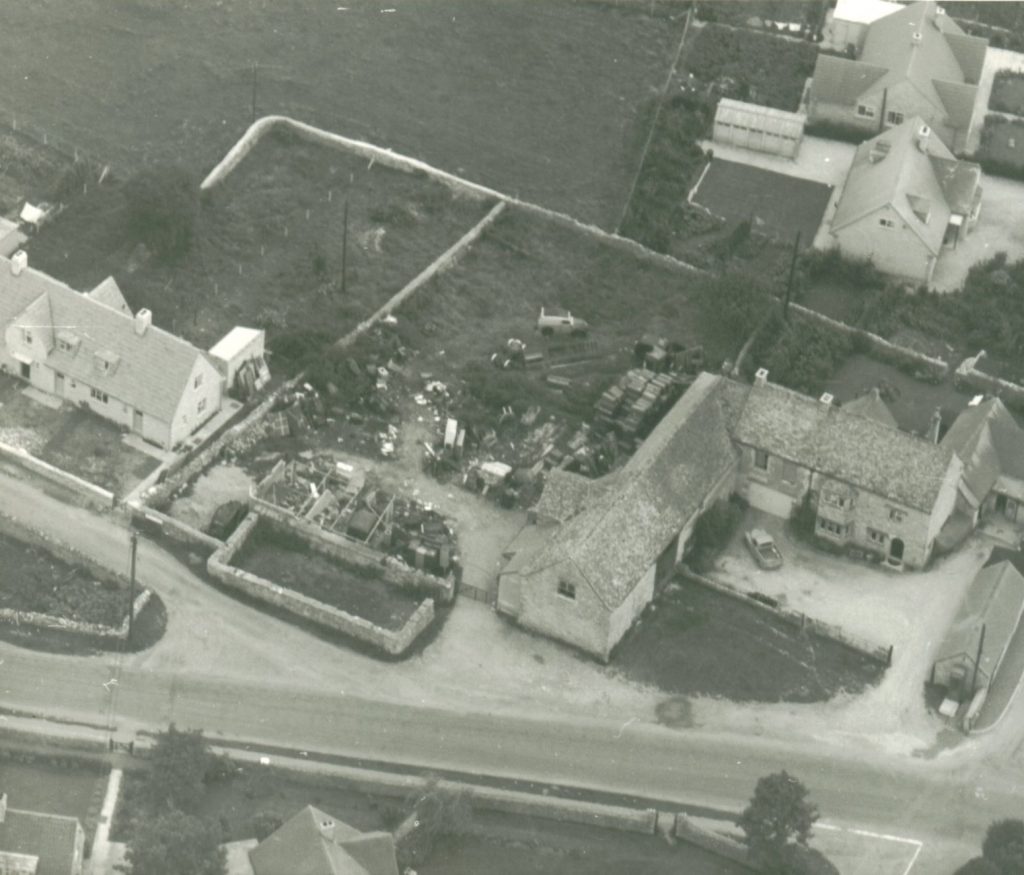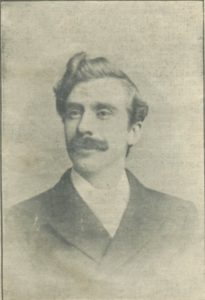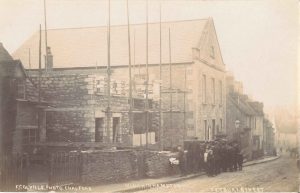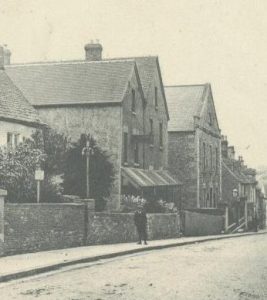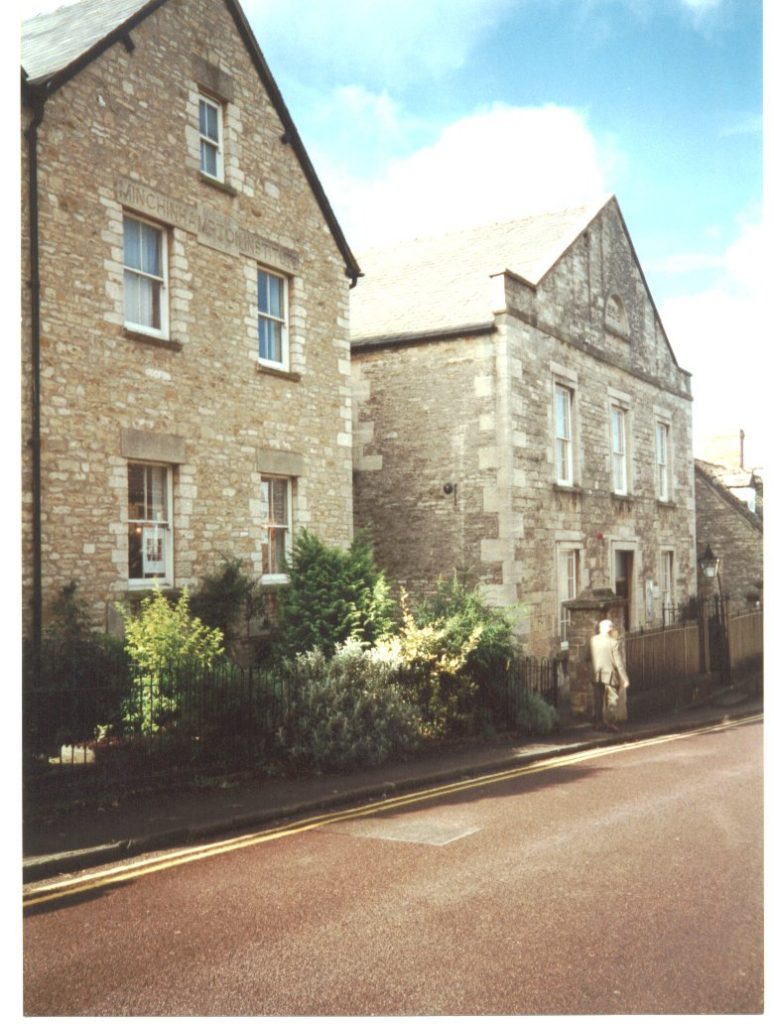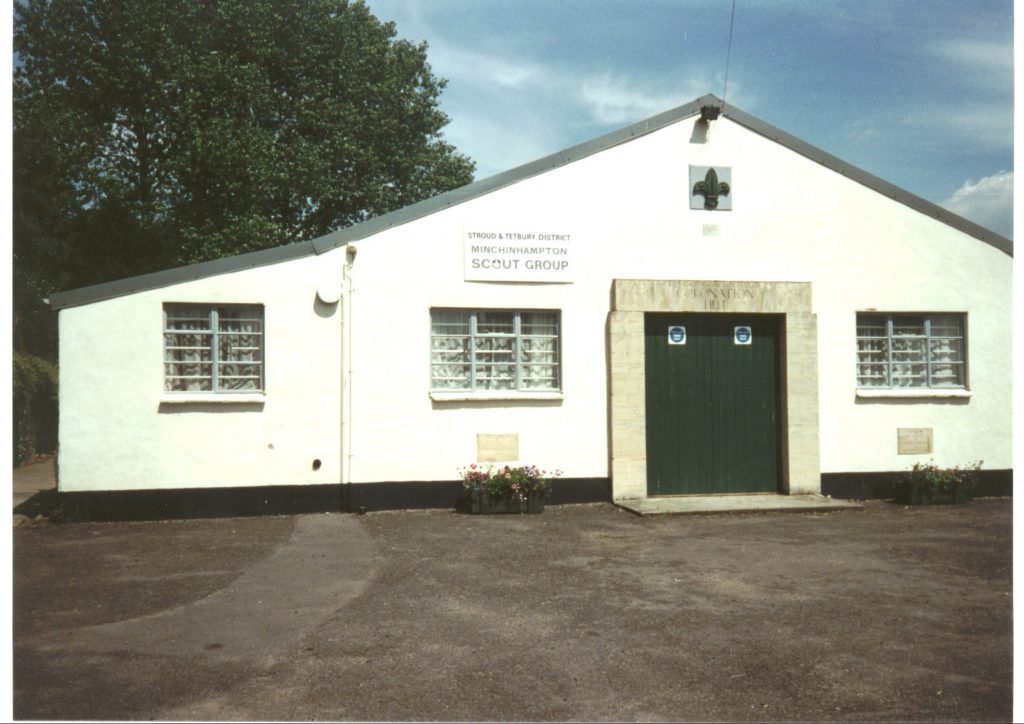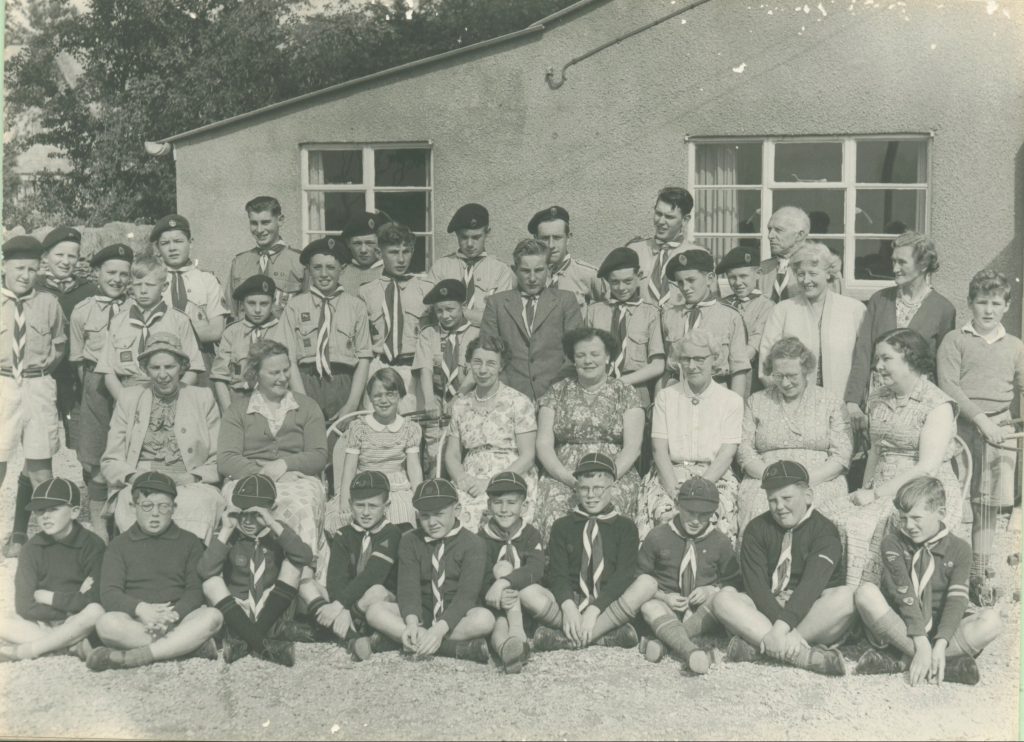ARDEN HOUSE AND COTTAGE
Arden House and Arden Cottage are two unequal-sized halves of one dwelling, which appears to have its origins in Tudor times. It is built parallel to the High Street, unlike many of its neighbours to the south and east across the street, which are aligned with their gable ends as frontages.
Arden Messuage (if it may be called that for clarity) occupies an important site in the centre of Hampton. In mediaeval times this comprised Holy Trinity Church, with the Manor House adjoining, with the demesne land to the north. The Market Place, wider than at present, lay to the east of the church; the surviving Market House was built in 1698 on part of the land, an earlier one at Upper Island had been built c 1600, and a third at Lower Island sometime between the two dates. However, it is safe to assume that until these spaces were infilled, the main focus of the town was the Market Place (now termed Market Square and High Street) where shops and traders were listed in the manorial records. (“ The Manor of Minchinhampton in the early C17th” by Cyril Turk in “Minchinhampton Life and Times ”, published 2000)
Without access to early deeds, and the names of owners at the period corresponding to surviving records, it is difficult to be precise about the function of Arden Messuage. However, it does not appear in any extant lists of manorial property, or of church property in the town, thus suggesting ownership by a freeman, yeoman or gentlemen. The property still called “The Crown”, which abuts Arden Messuage to the north, first appears in the Churchwardens Accounts for 1712. This is, and always has been, the major inn in the town, and by inference can suggest the importance of a position on the Market Place.
Could Arden Messuage have been used as a meeting or courtroom for the town (or indeed the tithing centred on Hampton)? It certainly exhibits features similar to Speech House in the Forest of Dean, and moot halls in East Anglia, and until the Market House was built some building must have been used. The Court Leet (“Where the Cow is King” by J.V. Smith, published 2005) would have been held every few weeks; the only other possibilities are in the Manor House, or Holy Trinity Church. Research has so far not identified either of these as being utilised.
The latter division of the building and its subsequent use, particularly as shops before World War I, has obscured some of the features that might have clearly identified earlier purposes for Arden Messuage. However, solely on the position alongside the major commercial space of the town, it can be inferred that this was an important element in the landscape and function of Hampton.
******************
THE BAPTIST CHURCH
The three-bay Baptist Chapel stands proudly behind its distinctive railings on the south side of Tetbury Street, the date stone in the pediment pronouncing 1834. However, this was not the first chapel in Minchinhampton, and, probably as a result of George Whitfield’s preaching on the common, groups of Protestant Dissenters were meeting together for worship, prayer and Bible study in each other’s homes. The Rev. Benjamin Francis became minister of the Baptist Church at Shortwood, frequently visiting surrounding towns villages and hamlets and almost single-handedly raised funds for the purchase of a piece of land in Workhouse (Chapel) Lane, and the erection of a meetinghouse costing £400 which opened for services in 1765. It remained a preaching station under the oversee of Shortwood for nearly sixty years, during which times there were many vicissitudes, but Rev. Francis continued to visit, “No difficulties deterred him from his arduous labours. He even persisted in his unwearied efforts for the good of the inhabitants of Minchinhampton, notwithstanding his want of success, of which he had more reason to complain than in any other instance.” Following his death in 1799, although the small chapel was furnished with pews and improved, congregation numbers slumped, and it was closed.
Matters improved with the appointment of the Rev. Joseph Baynes as assistant minister at Shortwood in 1818. Under his enthusiastic leadership the chapel reopened, regular services were held and numbers swelled. Talks began on the desirability of Minchinhampton becoming a church in its own right, and on October 7th 1824 it became independent with Shortwood’s blessing.
The first minister was Rev. Joseph Dunn, who conducted the earliest baptisms in Minchinhampton and so successful was he that the congregation rapidly outgrew the meetinghouse in Workhouse Lane. David Ricardo sold a larger site, shown as a void cottage on the 1830 map of the town, to the members for five shillings. He also provided stone, although sadly no records exist of the actual building operations. The cost was £1000, and it was opened in 1834, seating a congregation of 650 on the ground floor and galleries, with pews and an organ. The old meetinghouse was modified to accommodate an ever-growing Sunday School.
As with every organisation there have been changes over the years. By 1856 the congregation was again small, and there were fears the chapel might close and be sold, but matters improved and by 1878 a Manse had been purchased, improvements made to the interior of the chapel and vestry rooms added. Early in the C20th the Institute (Church Centre) was built on an adjacent plot, largely by the efforts of the members themselves, and in 1924 the Centenary was celebrated in grand style. The ministry of Rev. Alan Edwards began in 1967 and ten years later a completely reconstructed church was opened within the old walls, “to the Glory of God and to serve Minchinhampton in the twenty-first century”. The galleries were removed and replaced by upstairs rooms; the wooded pews were replaced with more comfortable chairs and the pipe organ rebuilt on the ground floor. The old meetinghouse was sold, and expertly converted into private accommodation.
********************
BLUE BOYS – INN, FARM AND HOUSE
Jocelyn Blanshard
The Blue Boys Inn sign depicts two youths standing either side of a dyeing vat as its supporters, their style of dress suggesting that the sign was painted in the late C18th. But this ancient wayside inn was in existence in the early years of that century, and the oldest part of the present building dates from the C17th. The sign is now displayed in The Museum in the Park, having been presented by Mr. William Clutterbuck Chambers of Thrupp House, who was a former owner of Blue Boys Farm. Under the sign is the inscription “Tho’ we stand here in Wind and Rain, True Blue will never stain”, denoting that the quality of the dyed cloth would withstand all winds and weathers. The young men are dressed in blue clothes, but their hands and faces are not stained.
Local legend recalls that many years ago young men from Minchinhampton worked in dyehouses in the neighbouring valley mills, returning home stained from the indigo dye. In the mid C17th Wimberley Mill, Bourne, as well as St. Mary’s Mill, Chalford, are known to have been making and dyeing cloth, and both these mills were within easy walking distance from the Blue Boys site. Spring Mill, Cowcombe (later known as Randall’s Mill), is recorded in 1711 in a Minchinhampton Manor document as being “leased with Messuage and Dyehouse for three lives to Joan Randall and her grandsons James and John Teal.” (G.R.O. D131 T/14) The Black Gutter, a feeder stream into the River Frome, powered this mill. Another accessible place of employment, but in the Nailsworth Valley, was Egypt Mill, which in 1695 was leased as a tenement, two fulling mills, a gig mill and a dyehouse by Henry Wilouby to Richard Webb. So it is very probable there is truth in the old legend, which gave rise to the unusual naming of this area as “The Blue Boys”.
It is evident that the Blue Boys Inn was a widely known location, as is shown in the following announcement in the Gloucester Journal, dated 30th August 1730: “Whereas on Tuesday Morning about 3 or 4 O’clock on 11th August was dropt a female child, on the court at the Blue Boys at Minchinhampton. Whoever will discover who left it, or the mother of it, as they may be brought to Justice, shall have five guineas Reward, paid by the Churchwardens.” A search in the churchwarden’s accounts for the ensuing few months did not reveal any payment of the reward!
The inn was a meeting place of some importance in the early part of the C18th, being used as a coaching inn for goods and passengers en route to Cirencester and London, and was also the venue for the Fair specialising in the traffic of horses. On 28th March 1749 the following advertisement appeared in the Gloucester Journal:
“CIRENCESTER FLYING-WAGGON,
Begins to Fly from the Blue-Boys, near Hampton, the 27th of March Instant, at Four in the afternoon, to the Ten Bells in Cirencester; and from thence proceeds directly to the Bell-Inn in Friday-Street, London, every Wednesday; and sets out from thence the same Night for the Blue-Boys as above, where it will arrive every Saturday Night all the Summer-Season. In which all Goods and Passengers shall be taken great Care of,
By their humble Servant, ANN MASTERS.”
The original 1751 turnpike went from the Blue Boys along the Old Common, and then turning left it emerged onto the present road near the Hyde junction. The siting of the Blue Boys is parallel to this old turnpike, not to the present Cirencester Road. The present piece of road from Blue Boys to the Ragged Cot was built in 1783 . The sunken area by the Fox and Goose (of which more later) belonged to the Commissioner of Roads in 1830, and was perhaps used as a source of road building material. In “Notes and Recollections of Stroud” Fisher states: “The growing prosperity of Stroud and its neighbourhood required better roads, and in the year 1751 by the Act of 25th George II powers were granted for repairing the highway from Cirencester to a house called the Blue Boys near Minchinhampton, and from thence over Hampton Common down the steep side of the hill through the village of Rodborough, and to the lower part of Stroud”. Issac Taylor’s map of Gloucestershire, first published in 1777, shows the Blue Boys on the turnpike road from Cirencester to Stroud.
As stated earlier the area surrounding the Blue Boys Inn was the venue for the Horse Fair, attracting horse dealers from many miles around. The Charter giving the right of a market and fair was dated 22nd September 1269. By 1760, however, the authorities of the town of Minchinhampton had decreed (for some reason not apparent) that the Horse Fair was no longer to be held at the Blue Boys, and this notice was published:
“THIS IS TO GIVE NOTICE
That the Horse Fair that was usually held some time past at the Blue Boys in this Town, will in the future be holden at the top of the West End of the said Town, in a certain piece of ground now in the possession of Messrs. Benjamin and Henry Sheppard, Wheelwrights.
SIGNED: William Clift, Town Bailiff of the Said Town.”
(Gloucester Journal 27th May 1760) The fair was discontinued in 1868.
The Vestry minutes are another source of information, where the decisions of the local townsfolk seem to have been made with some considerable opposition. The announcement had been made in Church in July 1796 that the site of the Town Pound was to be moved to a new position at the Blue Boys, and there were certain persons who were adamant that there was no advantage in changing the site . (G.R.O. P217/VE 2/1) The Pound can still be seen at Blue Boys, so it may be presumed that the Rector (Henry Jeffries), the Curate (William Cockin) and Messrs. Gardiner and Earle lost their argument. In 1975 the Pound was conveyed to the National Trust by the Commons Commissioners, and is still under their protection.
The earliest documentation of the name Blue Boys is in 1718, when the marriage Settlement of Samuel Sheppard III and Anne, daughter of Edward Darell of Rockhampton, Surrey states: “All that Messuage, cottage, tenement, dwelling house or inn at the top of Butt Street in Minchinhampton called the Blue Boys, and stable and barn and ale outhouses thereunto belonging to same by estimation 5 acres, also one other close of pasture ground named the Butts Piece by estimation 8 acres, also three messuages, tenement, dwelling house adjoining one another and gardens, outhouses and appurtenances belonging in Butt Street, lately demised by Samuel Sheppard to Elder to Margaret Cook by indenture 13th August 1717, to hold immediately after the death of Nathaniel Cook, clothier for 99 years, if the said Margaret Cook and Grace Pitman should so long live, at an annual rent of £8.2s.0d.” . (G.R.O. D131 T/14)
Nathaniel Cook continued as overseer of the estate at the top of Butt Street until his death in 1736. A document dated 1725 (G.R.O. D1198) testifies his administration of leasing the three tenements, which entailed his appearance before the Manor Court to transfer the second tenement from Samuel Millard to Thomas Hollyday. This was in all probability the Blue Boys Inn and the five acres referred to in the 1718 Marriage Settlement. It would appear that eight years later Thomas Hollyday wished to dispose of his lease, because on 6th November 1733 the Gloucester Journal ran this advertisement:
“TO BE SOLD A leasehold estate called the Blue Boys at Minchinhampton in the County of Gloucester for three lives, being a well-accustomed inn, a good brew house, with a good well in it, good cellars, a stable and barn with six acres of pasture ground adjoining to the said house bound round with a good wall, at one shilling per year chief rent. Enquire of Thomas Holyday at Hambrook in the parish of Winterbourne near Bristol, or of Mr. Price, the Bristol Carrier, in Gloucester.”
The Blue Boys smallholding and pastureland remained in the ownership of the Sheppard family until 1806. In the ninety years prior to this the leasing was granted to three families of overseers. First, as already mentioned, Nathaniel Cook and his kinsfolk. On his death (4th December 1736) his widow Margaret continued to pay rent for a dwelling, but by 1741 the management had passed to Joseph Dangerfield and his three sons in turn, Joseph, Samuel and Thomas, until 1791 when Thomas Chambers became the proprietor. The Rent Rolls of the Manor of Minchinhampton 1724 – 1779 list the following:
1725 Thomas Hollyday for ye Blew Boys £4. 1s. 0d.
1744 Margaret Cook (rent) 6s. 3d.
1744 James Cantor for the St. Foin ground by ye Blew Boys £4. 0s. 0d.
1745 Joseph Dangerfield for ye Blew Boys £4. 0s. 0d.
1747 Joseph Dangerfield for ye Blew Boys £4. 0s. 0d.
1747 Margaret Cook (rent) 6s. 3d.
1747 James Cantor for the St. Foin ground by ye Blew Boys £4. 0s. 0d.
1749 Joseph Dangerfield for ye Blew Boys £4. 0s. 0d.
1777 Margaret Cook (rent) 12s. 6d.
1777 Samuel Dangerfield for ye Blew Boys £8. 0s. 0d.
1779 Samuel Dangerfield for ye Blew Boys £8. 0s. 0d.
The precise date of the transaction when Joseph Dangerfield senior became overseer of the Blue Boys estate is provided in an Assignment of Mortgage document as 20th February 1741 (G.R.O. D131 T/14) An old list of victuallers and their sureties (G.R.O. Q/AV2) shows that there were twenty trading in Minchinhampton in 1755, and confirming that Joseph Dangerfield was then the innholder of the Blue Boys, and that his two Sureties, who each paid £10, were William and Robert Dowdy.
The 1777 Survey of Minchinhampton (G.R.O. P217/3/1) provides more detailed information of Samuel Dangerfield’s obligations as occupier and proprietor.
1. The Folly (later The Yews) – Pasture – 2 roods 20 perches
2. Great Cosborns – Arable – 8 acres
3. Little Cosborns – Arable – 5 acres 1 rood
4. Blue Boys Land – Arable – 4 acres and Pasture – 1 acre
5. Butts Piece – Arable – 7 acres
6. Rousetowsy Dutton’s Grove – Pasture – 25 acres
(owner Wm. Cantor)
7. Knaves Hall, Spring – Pasture – 1 acre 2 roods
(owner Edward Sheppard)
8. Blue Boys Park – Pasture – 4 acres
(owner Edward Sheppard)
9. Doudy’s Piece – Arable – 2 acres 2 roods
(owner Miss Doudy)
TOTAL: Arable land 26 acres 3 roods and Pasture 32 acres 20 perches
The Land Tax records for the period after 1780 are extant, and give an idea of the relative sums paid. Thomas Dangerfield took over from his brother Samuel in 1788, there being only slight variations in the tax up to 1793. For the following three years Edward Sheppard’s name appears as the proprietor of the Blue Boys estate with a Mr. Longfold as tenant, although a change took place in 1796 when John Vines was granted the tenancy with Thomas Chambers as overseer. In 1805 John Vines was replaced by Charles Ayliffe as victualler of the Blue Boys Inn, and trade directories show that he continued there until the mid 1820s. The Land Tax for various dates is given below:
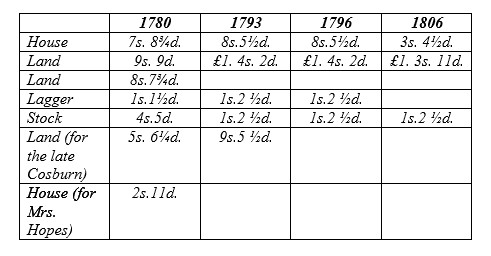
It will be seen that in the early C19th the rates were variable, and several surveys were made for the purpose of equalising the Poor Rate. The survey in 1803 shows that, as seven years previously, the proprietor was Thomas Chambers and the tenant John Vines and the ownership was still held by the Sheppard family. On 24th March 1806 the land and buildings were conveyed to Thomas Chambers of Forwood by the Sheppard family. The Chambers family, who were connected to the Clutterbuck family owned a large estate, including Forwood House ( M.L.H.C. 538). Thomas Chambers died on 11th April 1816 and the Blue Boys passed to his son Francis, and the 1830 survey map (G.R.O. P217a VE 1/2) records that the Blue Boys Inn, outbuildings and barns had been extended and a further piece of garden ground, measuring 1 rood 32 perches, had been added. An extract from the map and the relevant details of ownership are given below:
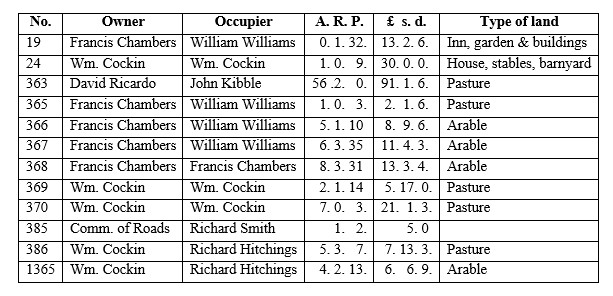
By the time of the next detailed survey and map, 1839, a few changes had taken place. Francis Chambers continued to use the 5-acre field (No. 368 on the map) but the rest of the land was leased to James Davis. The name of the victualler at the Blue Boys Inn was not given; however two years later the 1841 Census lists no less than eleven persons residing at the Blue Boys on that particular date, Wednesday 11th June. A probable explanation for this number of occupants could have been that they were visitors to the market and fair held annually on the Eve and Feast of Holy Trinity and the three days following; the last day of the fair in 1841 also being Census Day! The extract from the 1841 Census for Minchinhampton shows at the Blue Boys Inn:
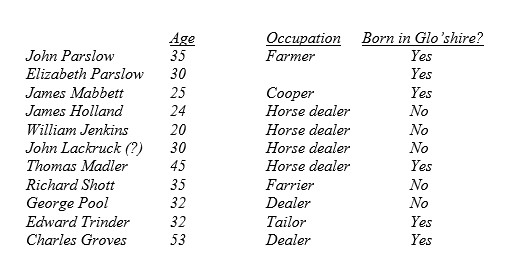
Ten years later in the 1851 Census Returns on Monday 31st March there again appeared to be an unusual number of occupants in the Blue Boys building, with no apparent reason for eight earthenware dealers to be visiting the Town, unless they were there in preparation for the weekly Tuesday market. The other occupants were:

Slater’s directory of 1858/9 lists William Pearman’s name at the Blue Boys Tavern, and he remained there until he died on 21st October 1875, aged 52, although by that time it was no longer functioning as an inn. The 1861 Census shows only four persons living at the Blue Boys:

The inconsistency of William Pearman’s place of birth in the two Census Returns is curious, as Denham and Weybridge must be about 20 miles apart.
It is thought that the Blue Boys Inn ceased trading in 1866, although the Slater’s Directory already referred to was the last to mention it under “Inns and Taverns”. No verification has been found for 1866, although that is the date mentioned in various articles from the “Stroud News” from last century (Stroud News June 21st 1929, Nov. 1st 1929, Apr. 6th 1934). The new Stroud/Chalford/Cowcombe turnpike opened in 1814, thus bypassing Blue Boys, and the railway came to Stroud in 1845, so these two events could have contributed to the decline of the inn. In the Cowle Museum the sign was displayed with the inscription “The sign of the Blue Boys Inn, Minchinhampton. It shows an indigo vat and dyers. The Inn, a posting house for the coach from London, was closed in 1866. Presented by W. Clutterbuck Chambers.”
There is a story told by a local villager that on the day the Blue Boys Inn closed a Mrs. Webb, who was a regular customer, was served the last pint. She had only a few paces to walk home, as she lived in the cottage with the sunken garden on the Cirencester road, formerly known as the Fox and Goose, which retains its stone carving to this day. William Pearman continued to live at the old Blue Boys, and in the 1871 Census he is listed as a farmer with 160 acres. After his death in 1875 his widow Emma remained living in Butt Street.
Mr. Pearman was, of course, a tenant of the Chambers family. Francis Chambers died on 9th November 1850, and Letters of Administration were granted to Mary, his widow. There were three sons, William Clutterbuck, Giles and Francis George, and three daughters, Emily, Esther and Mary. On their mother’s death on 9th April 1878 Letters of Administration were granted to the eldest son William Clutterbuck Chambers, but a lengthy settlement followed. On 20th July 1881 it was finally agreed that William Clutterbuck Chambers should purchase the Estate from his siblings, for £22,125. Part of this was the Blue Boys, at that time comprising the farmhouse, garden yards and buildings, together with a pasture close of 6 acres, and two arable closes of 6 and 8 acres. At that time the tenants of the house were James Morgan, a gardener, and his wife Bertha. Also living there were John Midwinter, a superannuated policeman, and Mary his wife, who was a dressmaker. John lived there until his death in 1894, and shortly afterwards began the occupation by the Summers family, which lasted until 1935.
The Electoral Rolls for Minchinhampton list George Summers as occupying the house and land from 1901 to 1906. His name does not appear again until 1915 and it is probable that he spent those nine years in Canada, where he had emigrated to farm. On his return he spent a short time at Blue Boys before building and moving to what is now “The White House” in Tetbury Street, where he lived with his wife Ann from 1918 to 1923. He then farmed Tobacconist Farm and after some years he moved to Shurdington, where he spent the rest of his life.
In 1907 Arthur Summers, his wife Alice and family became occupiers of the Blue Boys house and land. Arthur Summers had married Alice Munday Dean in the early part of 1886, and they had two sons (George b.1889 and Arthur b.1891) and three daughters (Jessie b.1887, Winifred b. 1896 and Evelyn b. 1897). At the end of World War I Frank Pilsworth and his wife Marion Rosina moved into that part of the of inn nearest to the barn, and continued living there for many years as neighbours of the Summers family.
Upon the death of Mr. William Clutterbuck Chambers in 1934, at the great age of 97, his solicitors were instructed to sell his Estate by auction. Lot 1 concerned the smallholding at Blue Boys farm, which included several fields scheduled as building land under the Town Planning Scheme (G.R.O. D4586/13) . The auction did not produce a purchaser above the reserve price, and the settling of the Estate was again a lengthy process. The Pilsworths continued to live in part of the farmhouse, but Alice Summers became ill and she and her husband moved into “Uniquea”, 19 Butt Street, with their son Arthur. Here Alice died in 1936, and her husband three years later.
Between these two dates, however, the Summers family made the big decision to buy Blue Boys farmhouse and some land. On 13th August 1937 Harold and Richard Chambers (sons of William Clutterbuck Chambers) sold to Arthur Summers Jr. The farmhouse and buildings with the three pasture fields to the southeast for the sum of £1,200. Two years later the field on the corner of Butt Street and Old Common was conveyed to Evan Hopkins of Tetbury, and was later developed for bungalows and houses. The old boundary of the field was preserved in the line of the new road – Summersfield Road.
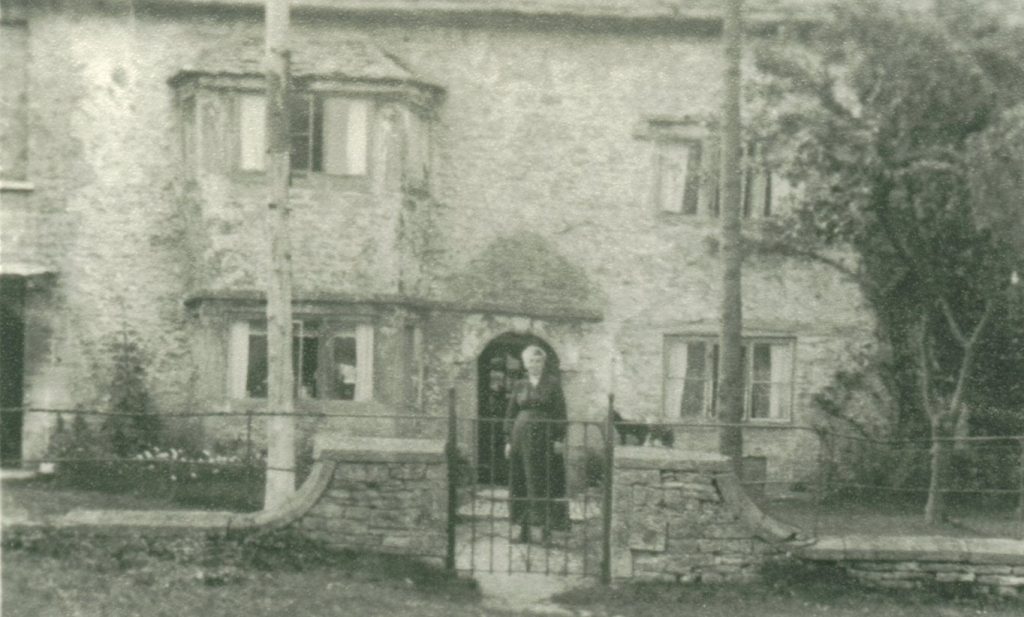
Mrs. Summers at Blue Boys
It was ten years later when the next document appears, the conveyance of a piece of land at the Blue Boys, together with the buildings described as the old farmhouse and skittle alley (in the occupation of Frank Pilsworth and his wife Marion), from Arthur Summers to William Critchley Wilkins, together with the right to use the lavatory! Mr. & Mrs. Pilsworth, who had been living there since 1918, were granted the right to live there as long as they wished, which in fact they did until they died. Mrs. Pilsworth was buried on 5th May 1953 and her husband a few weeks later on 30th June, aged 78 and 82 respectively.
The new owner of Blue Boys Farm, “Bill” Wilkins (as he was known to many when their dairyman) was related by marriage to the previous owner, albeit remotely. In 1953 Mr. & Mrs. Wilkins moved from “Wood Cottage” in Chapel Lane to Blue Boys. Major alterations were carried out to the house by the firm of J. Hatherall, builders of Hampton Fields. The cellar was filled in, which was a pity as it had a flagstone floor and rough plastered walls, ideal for cool storage. The two photographs below show the external changes to the house, with the changed position of the doorway and window alterations. Behind the old doorway was a spiral staircase, also removed at the time. Whilst repairs were in progress two Sun Alliance Fire Insurance plaques were removed, possibly when the walls were being repointed. Only one was replaced, and bears the number 612225, which, according to records, was issued between 1790 and 1795.
Formerly there was a bowling alley running alongside Butt Street, which Mr. Wilkins, and probably Mr. Summers before him, used for storing vehicles. There was also a piece of land alongside Butt Street, which formed a ditch, but the cattle got into it that formed a health hazard. The local council took over responsibility for the piece of land, and created a pavement. Mr. Wilkins took down the boiler chimney, which had stood at the rear of the property for many years, in 1961, by which time he had become firmly established as a dairyman making deliveries to all parts of Minchinhampton.
At the same time Arthur Summers sold the farmhouse, he probably disposed of his remaining two fields, south and east of Summersfield Road. These were purchased by Stroud R.D.C. and developed over a period of time into the Glebe Estate . Mr. & Mrs. Wilkins always regretted that they had not been able to afford to buy the large stone barn adjoining, which according to experts was built in the early C19th. Mr. Eric Vosper purchased it for £500, and for many years it was used as part of a storage yard, as shown on the aerial photograph below. In 1987, however, it was sold to Mayrose Developments, who converted it into two self-contained dwellings.
In 1966 Bill and Muriel Wilkins retired from business at the Blue Boys Dairy, and moved to a bungalow in Hampton Green. Muriel died on 22nd June 1982, and Bill remained a familiar figure as he walked his faithful dog over the Common and into Minchinhampton, twice every day. He died on 16th February 1989.
The dairy business was taken over by Mr. & Mrs. Lines, who extended it with a fruit and vegetable shop, and later a frozen food centre. However, increasing numbers of people chose to shop in the supermarkets of Stroud or Cirencester, and Jim Lines retired from business in 1998, and the Blue Boys once more became a private house.
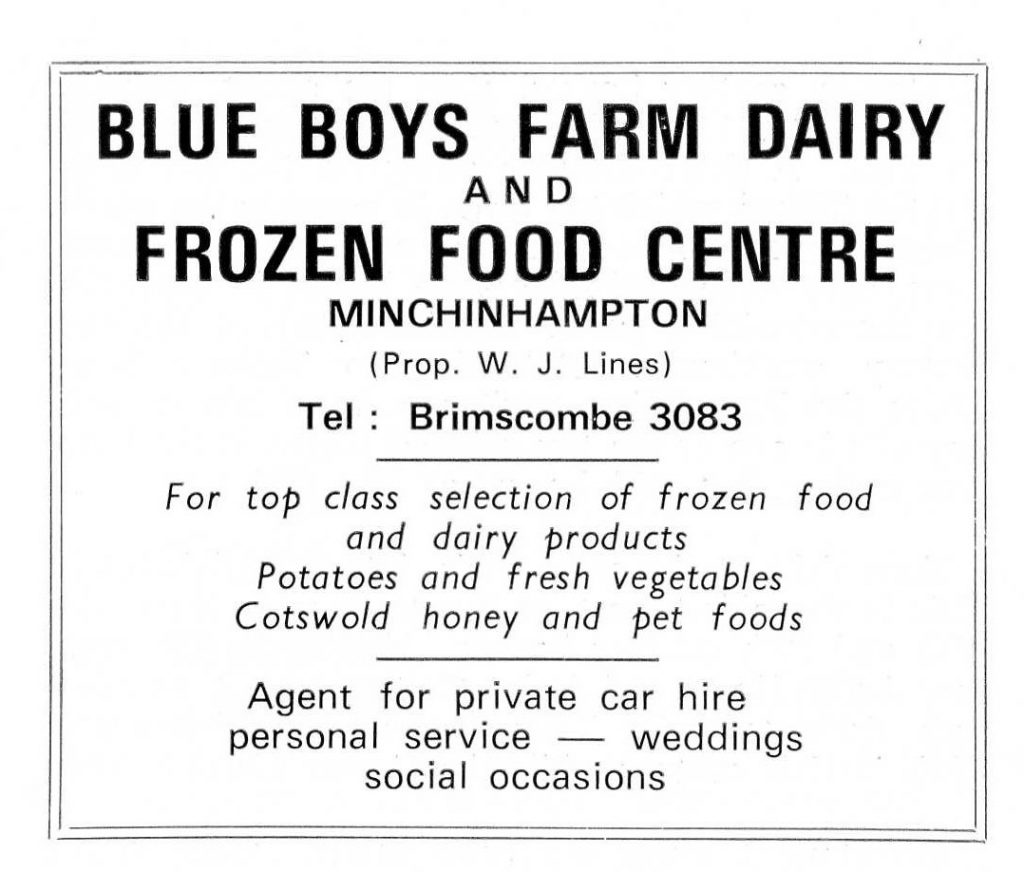
********************
THE BAPTIST CHURCH CENTRE (formerly known as THE INSTITUTE)
In the Edwardian times there was a very forward-thinking minister in charge of the Baptist Chapel in Tetbury Street – the Rev. S. J. “Sammy” Ford. Along with many of his growing congregation, consisting largely of mill hands and agricultural labourers, he had renovated the chapel building, the Sunday School and the manse. He felt that there was a need for a meeting place for the working men of Minchinhampton, which was other than a public house, being himself a supporter of the Temperance movement. From this vision was born the Institute, and “as in the case of the Jews, when Nehemiah undertook the building of the walls of Jerusalem, it may be said that “the people had a mind to work””
The site selected was next to the chapel, and necessitated the demolition of an old cottage. This task was undertaken by the minister, with a band of voluntary labour of some fifty or sixty men and boys (plus a few girls), commencing in June of 1906. The task was speedily accomplished, and the building proceeded at such a rate that the memorial stones were laid the following January. The building firm employed was that of Wall and Hook, who had a good local reputation, but again voluntary labour was used to keep costs to a minimum. The estimated cost was £1000, of which over £600 had been pledged by the stone-laying ceremony, either in money or promised labour. In the event, the final costs were met by subscriptions, all of which are recorded, along with the gifts of labour, materials and furnishings for the new building.
The stone-laying ceremony was marked by a great celebration. The Minchinhampton Band accompanied the singing of the hymns, and Rev. Ford outlined his vision for the use of the building. The five stones were laid, “By Henry Clarke of Frampton Mansell to commemorate the 10th year’s ministry of the Rev S.J. Ford in this town”, “By Alfred Apperly Esq. of Rodborough on behalf of the Working People of Minchinhampton”, “By Alfred Archard Esq. of Bath, president of the Bristol Baptist Association” “By Ulrich Holborow Esq. of Stroud on behalf of the Temperance Society” and “By Arthur J. Clarke Esq. of London on behalf of the young men of Minchinhampton” … Hymns were sung between each laying ceremony and speeches also delivered by those upon whom devolved the honourable duty, one and all complimenting those engaged on the work already accomplished and expressing a sincere hope that all their desires and hopes would by realised to the full.” (Stroud News, January 18th 1907)
Inside, the building consisted of a large downstairs recreation room, for the young lads of the area, above which was a similar sized room for the men. Both were equipped with games such as bagatelle, billiards and table skittles, but smoking was only permitted upstairs. Equally important in the days before cottages were fitted with modern amenities was the bathroom and dressing room provided behind. A large gas geyser provided the hot water, which was much in demand after cricket or football matches that were played at the top of Tetbury Street. Above these rooms was a reading room where “they hoped to make provision for daily and weekly newspapers and weekly and monthly magazines. It was their intention to make their institute non-sectarian and non-political so that it might become a neutral ground for friends of both church and chapel and of all shades of politics to meet on social terms one with another and enjoy a social evening.” (Stroud News, January 18th 1907)
The eastern part of the building formed the cottage for the caretaker, and was also used as a small temperance boarding house. Thomas and Kate Gardiner were the first caretakers, followed in 1935 by George and Minnie Ellins. Their daughter, Iris (later Dyer) remembered growing up in the cottage, with her parents and sister Poppy. “The Institute was well used during those early years up to and during the war… it was open six nights a week and there was table tennis upstairs, billiards darts and draughts downstairs, and in the rear room, always known as the bathroom, there were three bath cubicles for public use at 6d for a bath with piping hot water from a huge gas geyser. One of the upstairs rooms was a kind of museum but I don’t remember it being used very much and it was always kept locked. It housed some very weird stuffed creatures – a small crocodile, a duck-billed platypus, a large round fish that looked like a balloon with spines sticking out all over it, an animal’s skull and various bits of World War I memorabilia. This room always smelt very musty.
“The rooms were heated by individual old-fashioned cast iron radiators heated from underneath by a gas burner which we lit manually with matches. There was one big radiator in the billiards room and smaller ones elsewhere and I can remember how the walls ran with condensation on cold wet winter nights.
“Billiards was the most popular game, and time limits were set by the wall clock, which rang loudly enough, to be heard in the house when the time was up. For 3d you could have half an hour. Sometimes, elderly members coming in demanded, and got, the use of the table even though younger lads were playing – such was the way of life in those days.” (Unpublished reminiscences)
George Ellins had fought in World War I, and had lost most of his left leg, and was supposed to only do light work, but he was not that kind of man . During World War II there were boarders for most of the time in the house and the Institute was often commandeered for airfield construction workers, soldiers just returned from Dunkirk, evacuees, and the like. In spite of strict rationing, the family made outsiders welcome for meals, and in this way got to know a German P.O.W., a dispatch rider and his wife, as well as the army driver who had boarded with them pre-war. The public baths were used regularly by contingents stationed at Aston Down, and by the soldiers manning the searchlight battery at Hollybush Farm. Everyone wanted to “do their bit” and in 1944 Poppy prevailed on some local ladies to set up a contingent of the Girls Training Corps in Minchinhampton, with Miss Gladys Beale as the Commandant.
With the return of peace the Institute reverted to its pre-war role, and was increasingly used by more formal groups of members – the youth club, young wives, Sunday School classes etc. and the upstairs room was used for parties and other functions – both the Ellins daughters held their wedding receptions there. From the 1960s one room in the building was used to house the County Library, open two days a week, with a regular supply of books from the headquarters in Gloucester. However, in 1977 this facility moved into a purpose-built Library in School Road, and the Institute reverted to use by church groups, a Brownie Pack and by the Avening Band for rehearsals.
By the 1980s the Institute was in very poor decorative condition, but was still structurally sound. The cottage was in very poor state, and repair to both parts of the building would, it was estimated, cost in excess of £60,000. Rev. Alan Edwards had supervised the reconstruction of the church and engaged upon discussions with the authorities to see if the Institute and cottage could be converted to provide day centre facilities for the elderly. Nothing was finalised before Rev. Edwards left in 1986. Three years later the problem was discussed again, and the leadership team recommended to the members that the cottage should be sold and the proceeds used to finance the upgrading of the Institute to provide a “multi-purpose meeting place for use by ourselves and community groups”
A special Church Meeting approved the concept unanimously, and plans were drawn up to restore the Institute. Downstairs a large room for meetings of up to about thirty-five would be provided, new kitchen and toilet facilities installed, with an improved entrance area. Upstairs there would be four rooms suitable for smaller group meetings. Disabled facilities would also be part of the new interior. By the time all the relevant permissions had been obtained (not only from the Baptist Union Corporation Ltd. but also Listed Building consent) the original estimate of £57,000 had been revised up to £64,000, exclusive of fittings. After the sale of the cottage, and income from grants from different sources, a shortfall of over £16,000 was raised by the members to cover the building works and the fitting out. In 1992 the former minister, Rev. Alan Edwards was invited back to Minchinhampton to perform the opening ceremony of the Baptist Church Centre, which continues to fulfil its role for the Family Church (Sunday School), various church meetings and the wider community.
********************
THE CORONATION HUT
MINCHINHAMPTON SCOUT GROUP HEADQUARTERS
Diana Wall
During World War II in Minchinhampton, as elsewhere, Scouting had been in abeyance, although several local youngsters kept alive a spirit which had flourished in the town since 1909. In the 1930s the Troop met on Monday and Thursday evenings in the Gymnasium, behind what is now the Cotswold Club, but during wartime, if they could not hold outdoor meetings, they went to the belfry under the church tower. By 1950 there was sufficient interest, and the correct number of leaders, to re-form the 1st Minchinhampton Troop Boy Scouts. Sir Richard Bevan, the County Commissioner who lived in “Greylands” in the High Street, submitted the application, and on September 21st the registration was received, and Scoutmaster Trevor Kirby, took over.
The first post-war headquarters were provided by the generosity of the owners of Burleigh Court, Mr. and Mrs. G. Mackworth-Young, who kindly allowed the boys to use the stable loft. By the registration date Mr. Andrew Selway “an old friend and experienced Scouter” (Letter to Sir R. Bevan) had spent most of his holiday installing the necessary heating and lighting, and the Scout Room was also being decorated. Thanks to the owners the Scouts (but not the Senior Patrol) were allowed to use the swimming pool at the Court, a considerable attraction!
In 1953 the search was on for a suitable piece of land on which to construct a permanent headquarters. Amongst the possibilities considered were the old Simmonds’ site at Burleigh, the piece of land next to Walker’s Garage in Nailsworth Road and the land belonging to the P.C.C. in Friday Street (where the Youth Centre now is). Sir Richard Bevan had visited Canada earlier in the year and had obviously been talking to friends about the Troop “back home”. Thinking that a site with long-term tenure had been found, he wrote in May to Mr. J. W. McConnell, who had offered to subsidise a new Scout Hut. Five days later a draft for £600 (the full estimated cost) was being forwarded through the Boy Scouts Association of Montreal. A suggestion to name the headquarters “McConnell Hut” was turned down with a request “to keep his donation absolutely anonymous” and as he wrote in 1954 “The fact that you have a complete hut in your vicinity which you did not expect to have, is abundant reward for me.” (Letter to Sir. R. Bevan)
The land for the headquarters came from Mr. Norman Prince of Gloucester, then owner of Park Terrace. He asked the Parish Council to relinquish a piece of land 50ft. by 100ft. from the allotments in Dr. Brown’s Road, (which he presumably also owned) and this gift became a reality in September 1953.
The Scout Hut was to be professionally built by Mr. Cooper of Burleigh, but Scouts and other helpers did much of the groundwork. Work began on 3rd October with most Scouts, some only eleven or twelve, taking a stint of at least two hours at the weekend. The mild autumn weather was a bonus, and by the end of the year the concreting of the floor was complete. Only one sour note – a resident wrote in strong terms to protest at work being carried out on Sundays, which he felt was a poor example of “Duty to God” in the Scout Promise. The entrance was built with “gateposts wide enough to admit trek carts”. Work was slow in the early months of 1954, but the Scouts were tidying the site in March, levelling the mud, which was high around the walls, making access to the site difficult.
The Group Chairman at the time was Frank L. Smith and he worked tirelessly for the completion of the headquarters, obtaining fittings, grants for equipment and organising working parties. The walls of the hut, then measuring 50ft. by 26ft., were of concrete blocks, four girders were purchased in a sale and the roof was of corrugated asbestos sheet. Site meetings had agreed that the walls should be boarded on the inside, that cold water should be piped to the kitchen sink, and that a storeroom and cycle shed should be provided. The toilet was to be a shanty outside! Lewis’s of Stroud completed the electrical work and less than a year after building began the Coronation Hut was ready for its official opening.
Once open the Coronation Hut was in almost constant use. Not only did the Scouts meet on Monday, Wednesday and Thursday nights, but also at weekends. The Red Cross used it for courses, and for a time it was the home of a badminton club. As now, the Guides met in the hall. Important fittings were provided – a piano, table-tennis table, a radio receiver, boiler for the kitchen and chairs and tables. In these pre-television days it provided a useful social outlet for many boys in the area. Maintenance was a concern for the Group Committee, especially when windows were broken during indoor football matches! The storeroom was enlarged during the fifties, and a Senior Scouts room created at the back. Eventually inside toilets were provided behind the kitchen, and when the bungalows in Dr. Brown’s Road were built in the sixties, a further piece of land was purchased to the south of the building, to allow vehicle access to the rear of the premises.
Until the late Sixties there was a fairly large paddock to the rear, which, together with the land owned by Mr. A. Holloway next door, was the site of the Scout Fete for many years, until the need for a proper store for camping equipment, canoes and office facilities led to the construction of the current large storage area. Improvements have been ongoing in this area for many years; a donation from the 1998 Country Fayre enabled a proper staircase and storage shelving to be installed, enabling better access to the camping equipment for both Guides and Scouts.
The headquarters made the national newspapers in the eighties when “Princess Anne’s three-year old son started nursery school yesterday in a scout hut in the local village” . (The Sun, 24th January 1981). On the following Monday there was a scrum of photographers and reporters outside Gill Tomlinson’s school, and as this continued it became one of the few Scout huts to boast net curtains! Zara Phillips followed her brother to the school, which until recently used the building five mornings a week. Other regular users are the exercise and dance groups as well as both the Guide and Scout Movements – not a bad record for a building that reached its golden jubilee in 2003.
